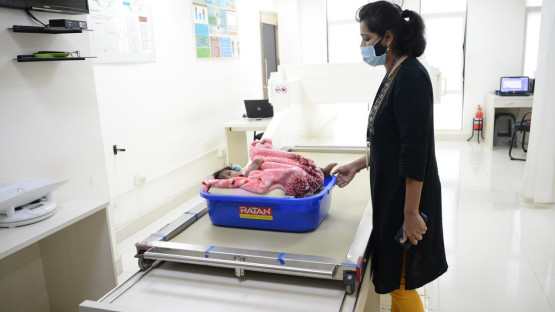The IAEA and India’s St. John’s Research Institute (SJRI) have agreed to increase cooperation to better understand the underlying factors of complex nutritional problems. The synergies of the IAEA and SJRI will allow tackling challenges countries face in nutrition.
Redesignated as an IAEA Collaborating Centre until 2025, the Institute will contribute to defining daily requirements of vitamin B12 and the dosages used in clinical supplementation and public health fortification programmes. Vitamin B12 deficiency is a widespread, growing public health problem globally with significant nutritional and clinical importance.
SJRI is working on developing a more accurate, non-invasive method to improve evaluating bone health of elder people and the responsiveness of interventions to prevent osteoporosis. To enable easier monitoring of child growth and body composition as part of bigger surveys, the Institute will develop and validate an App that measures length of under 3-year-old children, as well as body volume, body density and body fat in adults.
“We are looking forward to continue our joint work to contribute to capacity building through South-South collaboration, and to foster technology transfer in the use of nuclear techniques,” said Najat Mokhtar, IAEA Deputy Director General and Head of the Department of Nuclear Sciences and Applications.
Stable isotopes: core of successful collaboration
SJRI in Bangalore was designated as the first IAEA Collaborating Centre for Nutrition in 2010 and the designation was renewed in May 2016. With a focus on nutrition and lifestyle-related diseases, the Institute conducts high quality research in areas such as developmental biology and nutrition, macro- and micronutrient requirements across the life course, clinical nutrition, body composition, sarcopenia, bone health, metabolic flexibility and infectious diseases.
Research collaboration with the IAEA has focused on thematic areas that employ stable isotope approaches, including amino acid, protein and energy requirements; iron and zinc bioavailability; vitamin A status; maternal and child nutritional status, and environmental enteric dysfunction in infants during undernutrition.
More recently, SJRI has developed a non-invasive dual-tracer technique to assess protein and amino acid digestibility to inform protein quality recommendations for humans at all ages. It has also built a lower cost model of a total body potassium counter to accurately measure body cell mass of individuals with uncertain hydration status such as pregnant women, children in early stages of life and people with acute malnutrition or with cancer. This can help in the planning of nutritional interventions. SJRI has also produced videos and animations for the IAEA eLearning modules on nuclear techniques in nutrition.
Over the next four years collaboration will concentrate on developing biomarkers to measure bone homeostasis; simpler, safer and more accurate methods to assess functional status and absorption of vitamin B12; and an easy and field-friendly method to measure growth and body fat. Capacity building in the use of nuclear techniques in nutrition will remain an important focus.
“SJRI–IAEA collaboration on various aspects of nutrition has made significant contributions, especially to the developing world where inadequate nutrition is an important factor hampering human development to its full potential,” said Ambassador Jaideep Mazumdar, Permanent Representative of the Republic of India to the IAEA.
“We have been conducting numerous courses and workshops, and hosting fellows and scientific visitors for training in stable isotopic techniques in nutrition,” added Rebecca Kuriyan Raj, Head of SJRI Division of Nutrition. “Since the first designation in 2010, our laboratory facilities were gradually expanded through the acquisition of state-of-the-art mass spectrometers.”
SJRI provides analytical services for Member States and is engaged in technology transfer to many countries in Asia and other regions, through international training courses that combine theoretical and hands-on training programmes. In 2020, for example, the yearly Bangalore Boston Nutrition Collaborative course, conducted in collaboration with Harvard T.H. Chan School of Public Health and Tufts University, integrated a designated joint session with the IAEA on the use of stable isotope techniques in nutrition.
SJRI–IAEA collaboration has made significant contributions, especially to the developing world where inadequate nutrition is an important factor hampering human development to its full potential.






